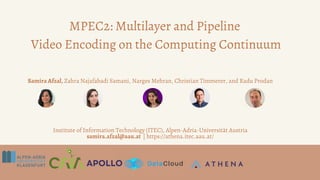
MPEC2: Multilayer and Pipeline Video Encoding on the Computing Continuum
- 1. Samira Afzal, Zahra Najafabadi Samani, Narges Mehran, Christian Timmerer, and Radu Prodan Institute of Information Technology (ITEC), Alpen-Adria-Universität Austria samira.afzal@aau.at | https://athena.itec.aau.at/ MPEC2: Multilayer and Pipeline Video Encoding on the Computing Continuum APOLLO
- 2. Agenda Motivation and main objectives MPEC2 Evaluated results Conclusion 1
- 3. Motivation and Main Objectives Video streaming is a significant part of the current network traffic Computationally intensive Costly Time-consuming Video encoding is Minimizing cost and/or minimizing encoding time Making a trade-off between encoding time and cost Considering encoding time deadline and cost limitation To select Cloud/Fog resources for video encoding/transcoding operations, aiming at: 2
- 4. Motivation and Main Objectives Video streaming is a significant part of the current network traffic Computationally intensive Costly Time-consuming Video encoding is Minimizing cost and/or minimizing encoding time Making a trade-off between encoding time and cost Considering encoding time deadline and cost limitation To select Cloud/Fog resources for video encoding/transcoding operations, aiming at: 3
- 5. MPEC2 Multilayer and Pipeline Video Encoding on the Computing Continuum (MPEC2) 4
- 11. 10 Objective Function Segment scheduling objective Stream scheduling objective
- 12. Objective Function Segment scheduling objective Stream scheduling objective Media service provider or user priorities 𝛼 ∈ [0, 1] Time-optimized (𝛼 = 1) Cost-optimized (𝛼 = 0) Encoding application Completion time Total cost Segment Instance Scene's segments 11
- 13. MPEC2 Architecture Overview Selects an instance type optimizing the objective O1 Distributes segments in a pipeline model on the instances optimizing the objective O2 Coordinator 12
- 15. Experimental Infrastructure Video Stream Characteristics 14
- 16. Evaluation Segment encoding scheduling Scene encoding scheduling Related work comparison 15
- 18. Time vs. Cost-optimized Scenarios Time-optimized results are 86 % faster and 77 % more expensive than the cost-optimized ones 17
- 21. Time-optimized Scenario Segment encoding scheduling Coordinater on c5a.2xlarge (Frankfurt) 20
- 22. Time-optimized Scenario Segment encoding scheduling Coordinater on c5a.2xlarge (Frankfurt) 21
- 23. Scene encoding scheduling Coordinater on c5a.2xlarge (Frankfurt) Time-optimized Scenario 5 number of c5.9xlarge 10 number of c5.4xlarge 5 number of r5.4xlarge Total completion time 22
- 24. Cost-optimized Scenario Segment encoding scheduling Coordinater on c5a.2xlarge (Frankfurt) 10 number of medium Scene encoding scheduling Coordinater on c5a.2xlarge (Frankfurt) Total completion time 23
- 25. Related Work Comparison MAPO: is a multi-objective model for IoT application placement in a Fog environment selecting one instance type for encoding the video stream Random: selects one arbitrary instance type per scene to encode the video stream Fastest: selects the fastest instance type relying on the CPU speed to encode the video stream Cheapest: selects the lowest cost instance type to encode the video stream Narges Mehran, Dragi Kimovski, and Radu Prodan. MAPO: a multi-objective model for iot application placement in a fog environment. In Proceedings of the 9th International Conference on the Internet of Things, pages 1–8, 2019 1 1 24
- 27. Conclusions Proposed MPEC2 for video encoding application on the computing continuum MPEC2 method: Scene detection Segment encoding scheduling, utilizing a multilayer graph partitioning model Scene encoding scheduling, proposing a pipeline model Highlighted factors: User or media service priorities, such as cost and/or time priorities Resources priorities, location, type, cost, number of instances for each resource type Segment properties, such as duration, number of segments, segment encoding time Evaluated MPEC2 on a set of Cloud AWS and Fog Exoscale resource instances Achieved significant improvements: 24%, 54%, and 40% faster video encoding compared to MAPO, random, and fastest instance selection methods in time-optimized scenarios 60 %, 50%, and 5% cheaper compared to the MAPO, random, and cheapest methods in time-optimized scenarios 26
- 28. Thank you Institute of Information Technology (ITEC) Alpen-Adria-Universität Austria samira.afzal@aau.at https://itec.aau.at/ Have a great day ahead! APOLLO
